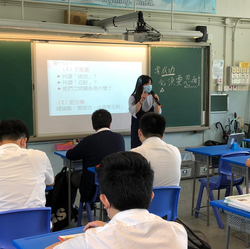Student sharing - Adapting to Change: From On-line to On-site Teaching

Switching between face-to-face and Online: Challenges and Learning in the Teaching Practicum
Vivian Mok
Bachelor of Education and Bachelor of Science
It has been a tough period for all teachers since the pandemic outbreak in early February 2020. During the four-month-long class suspension, the mode of teaching evolved greatly with heavy reliance on e-learning platforms. As a pre-service teacher, Vivian Mok from the Bachelor of Education and Bachelor of Science programme felt that this was a huge challenge, since she had to teach a new group of students whom she had never met in person before. Nonetheless, crisis creates opportunities. Online teaching became an excellent way for her to learn online classroom management as well as to practise questioning and interest-prompting skills.
In June, Vivian was able to complete her three-week face-to-face (F2F) teaching. In her first lesson, she was able to recognise only a few faces: those who had turned on their camera during the online lessons. Glancing at the 20 unfamiliar faces, she wondered how she could familiarise herself with all those students, build relationships and understand their nature as well as learning preferences within just three weeks.
After the long online learning period, Vivian’s mentor commented that students’ attention span was generally lower than before the school suspension. This meant another challenge, as Vivian had to incorporate more interactive and attention-grabbing activities in her lessons. At the same time, she was told to limit classroom activities and advised to avoid group activities in order to maintain social distancing. For her, it was really a struggle.
Vivian decided that it would be best to plan her lessons to incorporate a variety of pedagogical strategies, closely observing students’ responses to see which mode of teaching would engage them most. Knowing that the students were well adapted to self-directed learning, she encouraged them to prepare for the content-to-be-covered prior to every lesson. Such a practice was helpful as she could better understand their learning progress. She could then elaborate more on difficult concepts and clarify the students’ misconceptions.
Vivian also learnt to be more flexible in making use of different modes of questioning and group activities to keep students attentive and engaged. For instance, she played a phrase-chain game with the students, in which each group was asked to name a step in the transpiration process in chronological order, so that they could construct a complete description of the process sentence by sentence.
“The students’ attentiveness, capability to provide answers and to raise curious questions on the content taught reflected their interest in my lessons. The teaching experience has brought me greater confidence and flexibility for my future teaching,” Vivian remarked.

Reinforcing Teaching Skills for Future Teaching
Hung Ka Yan, Amanda
Bachelor of Arts and Bachelor of Education in Language Education - Chinese
Hung Ka Yan, Amanda from the Bachelor of Arts and Bachelor of Education in Language Education – Chinese programme completed her e-professional practicum (ePP) from April to May 2020 at Gertrude Simon Lutheran College in Yuen Long. She further completed a face-to-face (F2F) teaching practice at the same school for a week in June 2020. Although the pandemic was not yet over, the school still offered her the opportunity to take on a lot of teaching work.
During the ePP, Amanda assisted her mentor in designing various online worksheets and PowerPoint slides. The materials were used to teach the use of various figures of speech, the ways to analyse the keywords of questions and how to construct the outline of a composition, all of which would help improve students’ writing skills. She was happy to see that the teaching resources that she prepared were used by students for revision, which gave her a sense of satisfaction.
Amanda’s mentor asked her to teach Secondary 2 Chinese in the one-week F2F teaching period. Her duty was to help the class consolidate what they had learnt during the online lessons. Amanda then taught rhetorical and demonstration techniques and writing skills using the resources that she had prepared earlier.
As the students were used to online learning, which had been in place for several months, their motivation was relatively low when they returned to school for F2F classes. For example, students were more easily distracted during classes, and the learning atmosphere was not as dynamic. Amanda responded by changing her teaching strategies and stimulating students’ interest by giving out rewards and organising classroom activities.
“I am grateful for both the ePP and the F2F teaching opportunity. I especially appreciate the F2F teaching experience, as I was able to interact with students more and to better understand their needs. I learnt how to design courses based on students’ needs and to cater for learner differences, so as to retain students’ motivation and enthusiasm. The experience has been a great inspiration for my future teaching,” said Amanda.
